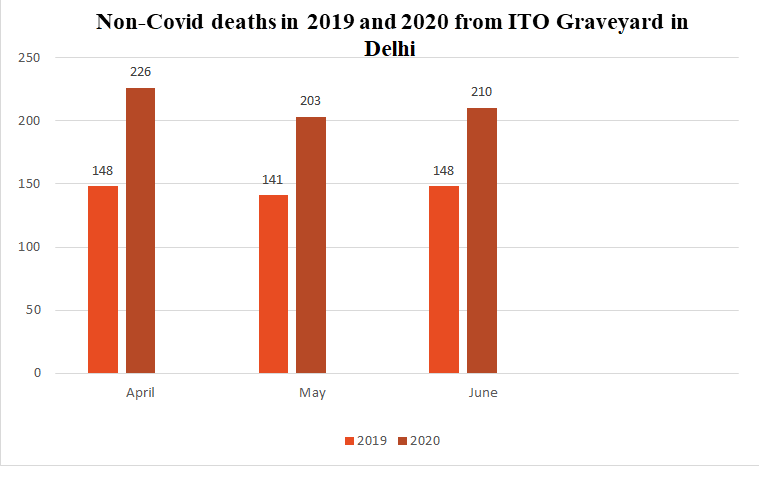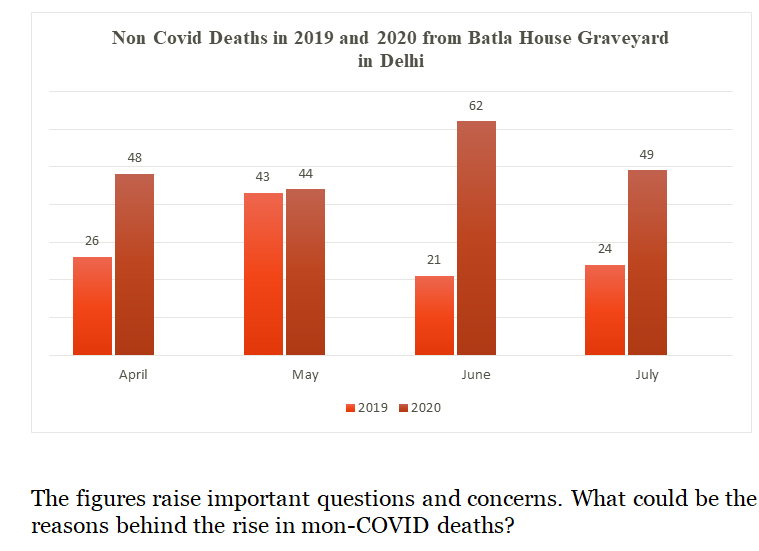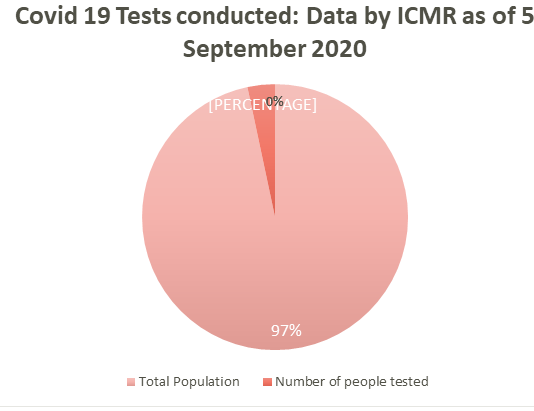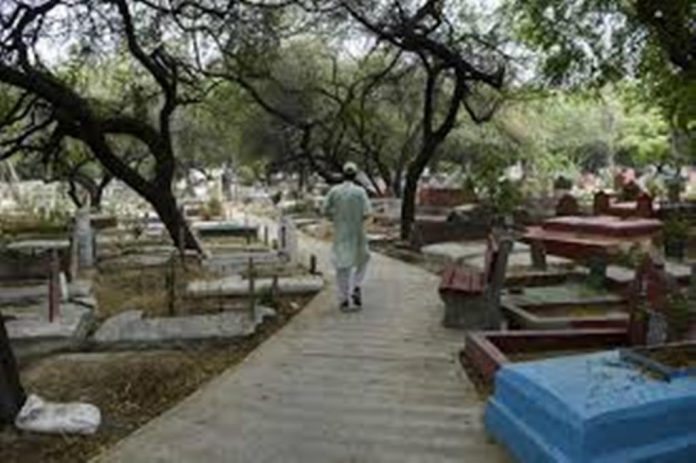By Laiba Zahid, TwoCircles.net
New Delhi: One of the most severely impacted cities in India by COVID-19, has been accused by opposition parties of under-reporting the Covid-19 deaths and cases. A Delhi Sero Survey also reported the same. While the data released by the Delhi government on the health bulletin says the total number of deaths caused by Covid-19 in April was 59. However, for the same period i.e. the month of April, the number of Covid-19 deaths recorded by TwoCircles.net from three burial sites (two graveyards and one crematorium) paint a different picture.
The data from the two graveyards and one crematorium directly contravenes with the claims made by the Delhi government and suggest an under-reporting of Covid-19 cases. When a single graveyard recorded 55 Covid-19 deaths, how can there be a total of 59 deaths in April due to Covid-19 in Delhi when the city has numerous crematoriums and graveyards?
The question that arises now is that how do we determine if the under-reporting has taken place or not and if so, what is the impact of this under-reporting and if it is being done and facilitated solely by the government to hide the crumbling health infrastructure of the city or not. There are multiple reasons why the under-reporting has taken place, from the wide spectrum of cumulative political assessment of the failed policies and their enforcement, awareness and management of the pandemic to the sociological stigma created around the pandemic, which was mainly propelled by the mainstream media.
A worker at the Nigam Bodh Ghat crematorium at Kashmiri Gate informed TwoCircles.net that on an average 60-70 Covid-19 infected dead bodies and 50-60 non-COVID dead bodies were cremated every day even in July when the Delhi government claimed that a 44 per cent reduction in Covid-19 deaths.
The ITO graveyard is also reported to be on the verge of running out of space that has been allocated separately to Covid-19 infected dead bodies. The graveyard has received almost twice the number of dead bodies when compared with last year. The figures released by places of burial site sharply contradict the ones given by the Delhi government.
Rise in Non-COVID Deaths
Apart from Covid-19 deaths, there has been an unprecedented rise in non-COVID deaths as well during the period from April to June 2020, when compared with deaths in the same period in 2019.
For instance, the chart below records the dead bodies buried at the ITO Graveyard in the year 2019 and 2020. There is a 52 per cent increase in April 2020, 43 per cent in May 2020 and 41 per cent in July 2020.
Batla House graveyard, which is not open to Covid-19 infected bodies, has also reported a steady increase in the number of non-COVID deaths. There is an 84 per cent jump in April 2020, 195 per cent in June 2020 and 104 per cent in July 2020.


The figures raise important questions and concerns. What could be the reasons behind the rise in mon-COVID deaths?
According to a researcher at Indian Council of Medical Research (ICMR), the prospect reasons for the rise in non-COVID deaths has been due to “the low levels of testing until July and people also taking symptoms lightly or confusing with other diseases.” Both the prospect reasons along with other factors turned out to be true when compared with the ground reports and stories. Low level of testing, poor management of some government policies such as cumulative death figures involving only those “where the primary cause of death is found to be Covid-19” (Delhi Health Bulletin), lack of access to healthcare and non-transparency in terms of releasing data are certain possible reasons behind Delhi’s low level of Covid-19 deaths.
Conclusive Possibilities
Investigating the reasons for the under-reporting of COVID-19 deaths, and conversations with several researchers, doctors and families affected by Covid-19 at the ground level, certain conclusive possibilities surfaced.
Low Level of Testing
One of the main reasons for the under-reporting was the low level of testing. There have been several cases where people had all the symptoms of Coronavirus but never got tested.
Naveen (name changed), 38, from Delhi was experiencing all the symptoms of Covid-19 but refused to get tested because he feared, “never coming back from the hospital because the government is treating Covid-19 patients inhumanely”.
Initially, Nargis’s (name changed), 58, family took the symptoms of Covid-19 lightly, confusing the breathlessness with pre-existing Asthma and fever with a viral fever. She passed away a week after having developed the symptoms. Despite a family doctor recommending getting Covid-19 tested, the family out-rightly denied. Due to the state government’s restrictions, the dead body could not be tested for Covid-19 after death and was therefore buried with the non-COVID infected dead bodies. It’s highly probable that India’s death rate seems low because of the low levels of testing even until September. According to ICMR, the total number of people tested till 5 September has been 4,77,38,491 that is 3% of total India’s population.

Failure in accessing healthcare
Another reason for under-reporting of COVID-19 deaths has been the failure of people in accessing healthcare. Healthcare services have been severely affected due to Covid-19. Many people have been avoiding hospitals for routine consultations due to fear of getting infected from Covid-19 through hospitals.
The state of government hospitals in Delhi is well known to be a cause of fear among people that used to rely on state services. Due to stringent lockdown and social distancing in hospitals, people are seen to be crowding outside the local clinics that do not have adequate facilities to meet with diverse health issues.
Telemedicine, consultation through private clinics have been a huge barrier to healthcare for people coming from non-privileged backgrounds. Certain doctors prefer not relying on telemedicine since most of the patients are unable to express the condition through phone call or video-call, but prefer seeing patients in person, however, with considerable hesitation and anxiety.
A neurologist working as a senior consultant at one of five Covid-19 dedicated hospitals in Delhi has not been able to follow up with his patients from Chhattisgarh and other states not surrounding Delhi not even at a private clinic.
He further explained that the number of emergencies in hospitals in terms of heart attacks have reduced considerably. Since neither the government nor the hospital authorities have been trying to find out the reason behind the sudden drop, the doctor explains it that the non-accessibility to the hospital could be a reason or the reduced physical and mental health issues. The doctor acknowledged that he does not have exact data to back the latter claim.
One of the doctor’s patients suffered an epilepsy stroke in April but could only reach the doctor in June owing to the fear of visiting the hospital. “While the hospitals are taking utmost precautions, I was scared because of the negative coverage in the mainstream media primarily,” the patient told TwoCircles.net.
The Indiscriminating Virus
The two oft-recurring factors throughout the research have been the failure of the state from the very initial stages in dealing with the pandemic in terms of regulating the lockdown, low levels of testing, and the stigmatizing of a health issue. This was mainly done by major media, which was manifested through expressions of pessimism and dismay, leading to ignoring of the clear signs of Covid-19 infection by the public.
What should have been dealt as a disease and a crisis that could have been handled more efficiently was gradually turned into a national security issue, the effect of which was felt the most by vulnerable groups in the society.
However, the discourse that was manufactured through the media not only affected the vulnerable groups (especially the Migrants and Muslims) but informal reports from crematoriums suggest an almost doubling figure of death when compared with the deaths last year spelling out the innate indiscriminately nature of the virus.

